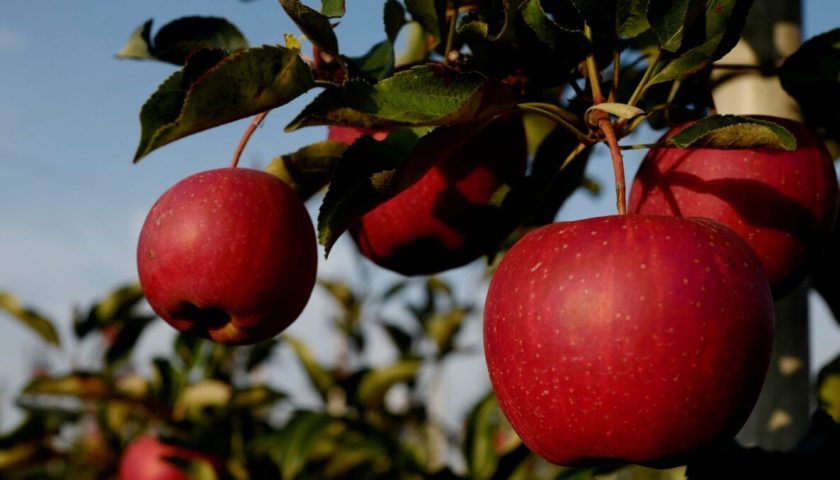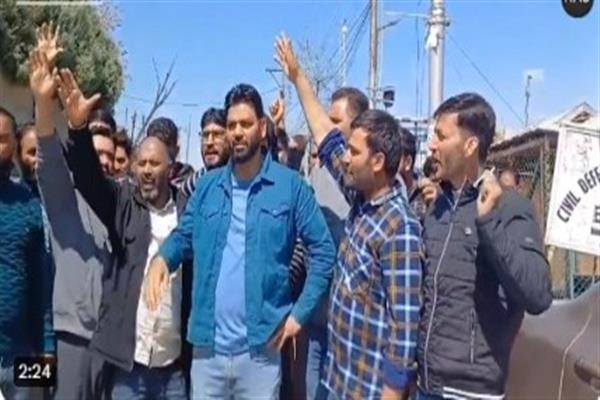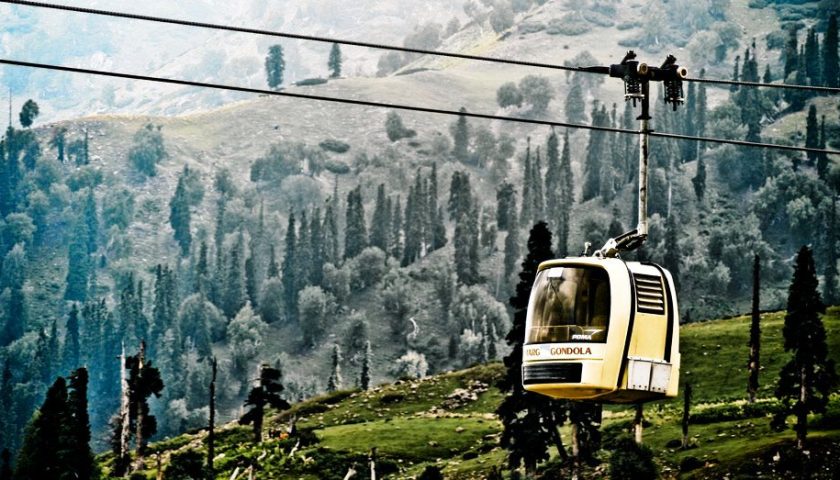Over the past two decades, migrant labourers from India’s heartland have become an integral part of Kashmir’s economy. In the past two weeks, 11 civilians, including migrant labour and non-Muslim Kashmiris, have been killed.
By Deeptiman Tiwary & Naveed Iqbal
With a forlorn look on his face, Sajjad Wani is puffing cigarette after cigarette. The owner of a furniture-making unit in Pulwama’s Litter in South Kashmir has a series of orders pending with him, but no workers to complete them. With logs of raw wood lying beside a row of intricately carved pieces and his machines covered in sawdust, the unit bears the look of a place that was busy till a few days ago.
On October 17 evening, one of his carpenters, Sageer Ahmed (55), was shot dead by suspected militants near his rented accommodation about 50 meters away from the unit. A resident of Saharanpur in Uttar Pradesh, Ahmed had arrived in Kashmir two years ago in search of work. Following his death, the seven other carpenters working at Wani’s unit — all from Uttar Pradesh — left the Valley, fearing for their lives.
“Under normal circumstances, they would have left in December before the snowfall. Now I don’t know how to deliver my orders. There aren’t many local carpenters available. Those who are, are either not good enough or absolutely lazy. Ahmed was not only very skilled at carving wood but also very hardworking. He was my chief carpenter and pretty much handled the operations of the unit,” says Wani.
A few kilometres away, Farooq Mir, a farmer, is thrashing bundles of harvested paddy with his family members to separate grains from the chaff. “Usually this work is done by labourers from Bihar and UP. But after the Litter killing, all have run away… If they do not return next year, harvesting will be a problem,” says Mir.
Over the past two decades, migrant labourers from India’s heartland have become an integral part of Kashmir’s economy. While they come from various states, including Punjab, Haryana, Rajasthan and Madhya Pradesh, those from UP, Bihar and West Bengal form the bulk. The Union Territory administration has no compiled data, and industry and trade bodies put their figure between two and four lakh. However, research scholars studying migrant patterns, and the 2011 Census data, say their actual numbers could be over 11 lakh in Kashmir Valley alone.
They are spread across sectors such as agriculture, manufacturing, construction and brick kilns, or work as barbers and hawkers. In fact, it is difficult to find a barbershop in Kashmir run by a Kashmiri.
“While most labourers leave by the end of November or December, only to come back by March next year, barbers stay on. They have their families here too. But this time even they have run away,” says Shamim Wani, who runs a bakery in Pulwama.
It is the second such exodus of migrant labourers from the Valley, the first seen soon after similar killings in the aftermath of the August 5, 2019, decision of the Centre, stripping Jammu and Kashmir of its special status and bifurcating the state into two Union territories. In the past two weeks, 11 civilians, including migrant labour and non-Muslim Kashmiris, have been killed. Those shot include Srinagar’s famous pharmacist Makhan Lal Bindroo, a Kashmiri Pandit, and a teacher and a principal shot at their school, sending shockwaves up to Delhi. Most of the killings are confined to Srinagar and South Kashmir.
Sajjad Wani says he didn’t have the heart to stop anyone from leaving. “I can’t guarantee my own life in this place. How can I guarantee anyone else’s? So I let everyone go.”
The Sopore Industrial Estate in North Kashmir has 56 units of different kinds, ranging from garments and furniture to PVC pipes and plastic garbage recycling. The estate’s president, Javed Bhatt, says they have managed to retain most of their labour as they stay on the estate itself, and police provide perimeter security.
However, the same is not true of other sectors, Bhatt says, and local labour is hard to come by. “Kashmir’s economy is heavily dependent on migrants, with their maximum presence in the construction business as masons, painters and carpenters. There is also household help from Jharkhand… Lieutenant Governor Manoj Sinha has sold us a dream that Rs 60,000 crore investment is coming from Dubai. Who will invest if this kind of environment continues and there is no workforce?”
What Bhatt draws confidence from is that workers who had left in the aftermath of the 2019 change returned next year as well as in 2021, despite Covid and security fears.
Fayyaz Malik, the general secretary of the Sopore Fruit Mandi, the largest wholesale market of apples in Kashmir, clocking an annual business of Rs 7,000 crore, says most of the buyers of their stocks are “outsiders”. Non-locals are generally not involved in the plucking, segregation and packing of apples.
“Traders and agents of arhatiyas, along with their labour from various states, camp here for six months to buy fruits and transport them. If the number of buyers goes down because of the fear, prices of fruits will fall. Already we have not had a good harvest the past couple of years because of weather changes,” says Malik.
Kashmir Chamber of Commerce and Industry president Sheikh Ashiq says last week business leaders held a meeting with the divisional commissioner. “We all expressed our concern at what was happening with migrants in the Valley. We told the government that this is going to hamper your development goals. All infrastructure projects are going to be delayed,” Ashiq says.
A senior government official said they are seized of the matter. “Security forces are doing their job and the situation will be back to normal. Ensuring security for a robust economic environment is a government’s commitment,” the official said.
Home Minister Amit Shah, who arrived in Kashmir on Saturday for his first visit post-August 5, 2019, and held a security review, recently announced that more than Rs 25,000 crore worth of investments have been locked in for J&K. The UT administration has claimed that JSW Steel is among four corporates which have decided to invest in the Valley.
Though Kashmir does not have much of an industry, it has always been a market for migrant labour. Locals say people have been coming from Bihar and UP to Kashmir for work for at least four decades.
Around the mid- 2000s, when the UPA government announced a Rs 24,000 crore “reconstruction package” for Kashmir and the Valley saw relative peace, these numbers surged. This also coincided with the saturation of labour markets in popular destinations such as Delhi, Punjab and Mumbai.
With Kashmir free of the debilitating poverty of many parts of the country and enjoying a high literacy rate, locals are hard to find menial jobs. Among the only places to fully implement land reforms, the Valley has few who do not own a piece of land or assets, helped by its low population density. One of the largest employers in UT is the government.
“Given that locals may not be interested in menial work, migrants are not as such a threat,” points out Prof Manish K Jha of the Tata Institute of Social Sciences, Mumbai. As part of his research on migration in India, Jha says he has found that, in the past decade, migrants have started exploring newer areas like Kerala, Manipur and Kashmir, far away from the heartland states to which most of them belong.
“To begin with, it was people who had some level of skills who went to these places — a carpenter, a mason. Once they went, they realised that while their skills had a premium, there was also a shortage of labour. Then through their networks, they informed others back home and they started coming. Then some of them became brokers or mediators,” Jha says.
Aijaz Ahmed Turrey, an Academic Associate at IIM-Ahmedabad, says the locals who once engaged in such work have either been absorbed by an expanding economy of fruits, transport or hotel or are happy to sit idle. “Some have even gone to the Gulf. There is always some piece of land they can live off,” he says.
Turrey, who hails from Pulwama, published a research paper on migrants in Kashmir in 2019. Estimating their numbers at 11 lakh, he says most of them are employed in rural areas.
Ashiq says the “outsiders” are also seen as more hardworking. “Hire a local and he will take three breaks during the day to smoke a hookah. Then he will leave early and demand higher wages. He will also have frequent family issues and take leave.”
Jha says labour in Kashmir also enjoys better living conditions. “Another thing migrant workers have told us during our research over the last two years is that living in Kashmir is not that expensive. Either through hospitality or other means, they do not have to spend much on housing. In Delhi and Mumbai, even with poor living conditions, they spend a lot more on housing.”
According to Jha, migrant workers are able to send remittances up to “50 per cent higher” in places such as Kashmir and Kerala.
Mohammed Nadeem, who works in an embroidery unit at the Sopore estate, came to the Valley two months ago from Bijnor in UP. The father of three says he is afraid because of the killings but has little choice but to stay on. “I worked as a tailor in Bijnor. However, work has really dwindled over the past couple of years. Because of Covid, earnings are low and inflation is high. People are not buying new clothes. But there is work here.”
Kamlesh Chauhan, 27, who has been coming to Kashmir since 2017 as a daily wager, left for home in Bihar’s Siwan district on October 23, confident he would return. “These things keep happening, there is nothing to fear. I have gone and come back several times. Yes, there is fear, but I am sure things will settle down. There is no work back home,” he says.
Mohd Lukman, 46, and Priyanshu Kumar, 23, who belong to the same village in Bettiah district of Bihar, share a rented room with four others, paying Rs 600 a month each, in Baramulla. They first came three years ago, after having worked in Punjab and Delhi.
“People there are very exploitative. They make you work for long hours and pay less than here. In Delhi, I would get paid Rs 500 and work for two to three hours more. Here I get paid Rs 600 and can go home at 5 pm,” says Lukman, who has four children.
According to the two, employers in Kashmir also arrange food for the labourers, which doesn’t happen in Punjab.
“Plus, here they treat you with dignity. You rarely have anyone using abusive language. Another great thing here is honesty. If they make you work extra, they pay you extra,” says Lukman.
Suraj Sahni, a fruit hawker in Srinagar hailing from Badaun in UP, says locals are generally nice to migrants and there is a level of trust. “I can leave my stuff or payment pending here and know that if I come back two years later, I will get it. I can run credits even as a newcomer. This would not happen in Delhi,” he says.
Priyanshu says for him the biggest attraction is the weather and better accommodation. “Until the winter sets in, it is pleasant here. You don’t feel very tired. Rooms are bigger so even with more people it doesn’t get claustrophobic,” he says, adding that the months that he is not in Kashmir, he works in Uttarakhand.
While most people believe the migrants leaving is a temporary blip, and that they will return, what has taken a beating is the Centre’s claim of restoring “normalcy” in J&K post abrogation of Article 370. “What can be more abnormal than the killing of migrant workers? It didn’t happen even during the peak of militancy. And the killing of Kashmiri Hindus and Sikhs is a throwback to those terrible times (of the early ’90s),” says a Srinagar businessman who does not want to be identified.
The administration is alarmed. After the October 17 episode in which two migrant labourers were killed at their accommodation in Srinagar, it moved them into secured shelters that came up overnight in government and school buildings. Sources said the migrants were also “encouraged” to leave, and their employers were told not to stop them if they couldn’t ensure their security.
Top officials, including members of intelligence agencies and Central Armed Police Forces, have been stationed in the Valley since October 17. During his visit, Shah was briefed on the steps taken to prevent attacks on civilians among other issues.
L-G Sinha has said that “every drop of innocent blood will be avenged”, and there have been a series of encounters since the killings, leaving 17 militants dead. Police claim many of them were behind the migrant killings. Scores of people have been picked up on suspicions of being “overground workers (OGWs)”, while police have resumed pat-down frisking — a much-maligned routine stopped in the Valley a few years ago.
IG (Kashmir) Vijay Kumar blames the civilian killings on “hybrid terrorists” or “part-time militants”, using small arms such as pistols to target defenceless individuals in the dark, before speeding away on bikes. Police believe many of these shooters are radicalised individuals who might even hold regular jobs while carrying out “contract kills”. It is thus harder for security forces to track them, tapping into their usual network. “In some cases, OGWs have been found directly involved,” Kumar has said.
However, the 17 militants security forces have killed recently, and claimed them to be behind the attacks on civilians, were all Kalashnikov-wielding full-time operatives, and not armed with small guns. Sources say these men might have been involved in planning and not necessarily executing the killings.
The attacks on the civilians have coincided with an influx of small firearms dropped by drones from across the border and increased infiltration since July. That the deployment of forces in the Valley is now down to pre-August 5, 2019, levels, has not helped matters.
Sources in the security establishment say things have been building up since July when intelligence inputs first suggested non-Muslims could be targeted in the Valley. But there have also been some immediate triggers.
A senior officer says the very public Independence Day celebrations, with multiple Tricolours, put up around the Dal Lake, and jingoistic slogans blared over loudspeakers, did not go down well at a time when the Valley is still bristling over the August 5, 2019, change, with no sign or restoration of statehood or elections around the corner.
The officer says there are resumed whispers of plans for a “demographic change” in the Muslim-majority Valley, especially after the launch of a portal for Kashmiri Pandits to complain about the property they sold in distress sales and a change in rules for buying of land in the Valley. “There is suspicion that a section of the local population supports these militants targeting outsiders,” the officer says.
In September, security agencies say, they came across a social media post by The Resistance Force (TRF) — believed to be an offshoot of the Lashkar-e-Toiba — that discussed a “strategy” to target “non-locals”, and criticised the government’s policies letting “outsiders” take up land and jobs in Kashmir. Sources said a TRF sleeper cell may be behind the recent attacks, and they were on the trail of some militants who had been identified.
But, Pulwama’s Sajjad Wani, who has been in the furniture business for eight years, says any action has to come fast. “If the police can’t find and neutralise these militants by winter, I will frankly have to shut shop.”






